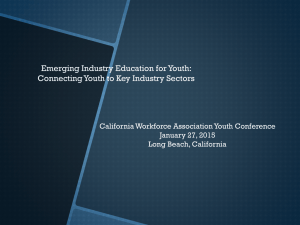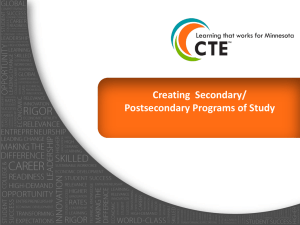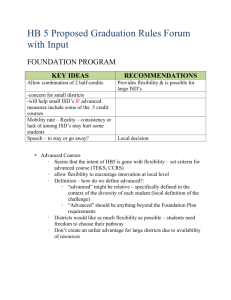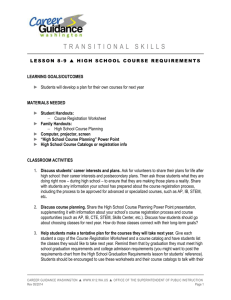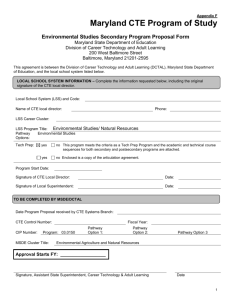Maryland CTE Program of Study - Maryland State Department of
advertisement
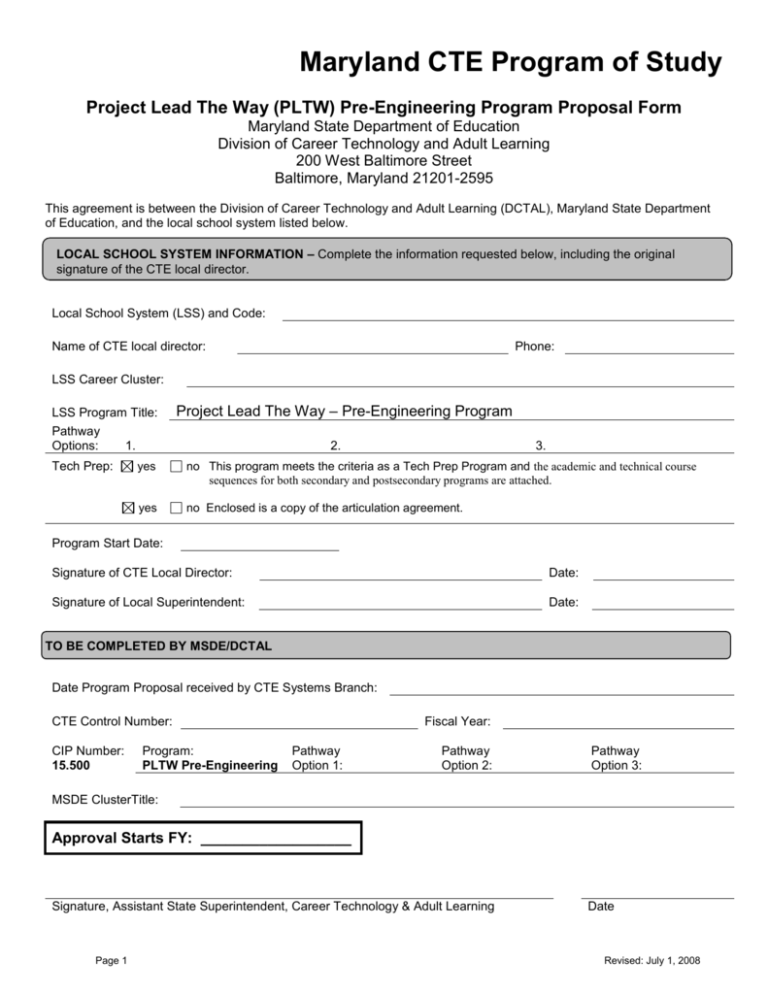
Maryland CTE Program of Study Project Lead The Way (PLTW) Pre-Engineering Program Proposal Form Maryland State Department of Education Division of Career Technology and Adult Learning 200 West Baltimore Street Baltimore, Maryland 21201-2595 This agreement is between the Division of Career Technology and Adult Learning (DCTAL), Maryland State Department of Education, and the local school system listed below. LOCAL SCHOOL SYSTEM INFORMATION – Complete the information requested below, including the original signature of the CTE local director. Local School System (LSS) and Code: Name of CTE local director: Phone: LSS Career Cluster: LSS Program Title: Pathway Options: 1. Tech Prep: Project Lead The Way – Pre-Engineering Program 2. 3. yes no This program meets the criteria as a Tech Prep Program and the academic and technical course sequences for both secondary and postsecondary programs are attached. yes no Enclosed is a copy of the articulation agreement. Program Start Date: Signature of CTE Local Director: Date: Signature of Local Superintendent: Date: TO BE COMPLETED BY MSDE/DCTAL Date Program Proposal received by CTE Systems Branch: CTE Control Number: CIP Number: 15.500 Program: PLTW Pre-Engineering Fiscal Year: Pathway Option 1: Pathway Option 2: Pathway Option 3: MSDE ClusterTitle: Approval Starts FY: __________________ Signature, Assistant State Superintendent, Career Technology & Adult Learning Page 1 Date Revised: July 1, 2008 CTE Secondary Program Proposal Contents STEP 1A: PROGRAM ADVISORY COMMITTEE MEMBERS AND THEIR AFFILIATIONS Complete the list of the Program Advisory Committee (PAC) members. Members should include employers, local workforce development representatives, economic development personnel, business, or labor representatives, and the remainder should include secondary and postsecondary, academic and technical educators and other stakeholders. Place a check in the appropriate box to indicate the role each person plays. Include all of the information requested for each entry. Use this form or a locally developed form – either one is acceptable as long as all information is provided. Program Advisory Committee List Membership: First entry should be the industry representative who is leading the PAC. PAC Leader Name: Title: Affiliation: Address1: Address2: City, State, Zip: State: Phone: Fax: Email: Area of Expertise: Work-based Learning Curriculum Development Role: Program Development Other (specify): Name: Title: Affiliation: Address1: Address2: City, State, Zip: State: Phone: Fax: Email: Area of Expertise: Work-based Learning Curriculum Development Role: Program Development Other (specify): Name: Title: Affiliation: Address1: Address2: City, State, Zip: State: Phone: Fax: Email: Area of Expertise: Work-based Learning Curriculum Development Role: Program Development Other (specify): Page 2 Industry Representation: Secondary Postsecondary Zip Skills Standards Validation Industry Staff Development Representation: Secondary Postsecondary Zip Skills Standards Validation Industry Staff Development Representation: Secondary Postsecondary Zip Skills Standards Validation Staff Development Revised: July 1, 2008 Name: Title: Industry Affiliation: Address1: Address2: City, State, Zip: State: Phone: Fax: Email: Area of Expertise: Work-based Learning Curriculum Development Role: Program Development Other (specify): Name: Title: Affiliation: Address1: Address2: City, State, Zip: State: Phone: Fax: Email: Area of Expertise: Work-based Learning Curriculum Development Role: Program Development Other (specify): Name: Title: Affiliation: Address1: Address2: City, State, Zip: State: Phone: Fax: Email: Area of Expertise: Work-based Learning Curriculum Development Role: Program Development Other (specify): Name: Title: Zip Skills Standards Validation Industry Page 3 Staff Development Representation: Secondary Postsecondary Zip Skills Standards Validation Industry Staff Development Representation: Secondary Postsecondary Zip Skills Standards Validation Industry Affiliation: Address1: Address2: City, State, Zip: State: Phone: Fax: Email: Area of Expertise: Work-based Learning Curriculum Development Role: Program Development Other (specify): Representation: Secondary Postsecondary Staff Development Representation: Secondary Postsecondary Zip Skills Standards Validation Staff Development Revised: July 1, 2008 STEP 1B: DOCUMENTED LABOR MARKET DEMAND – Check the appropriate box below. Demand exists The PAC will review labor market information on a local, regional and/or state basis. Check this box if demand exists for the identified occupations. The labor market information does not need to be provided with the proposal as long as there is a demand for employees according to data provided by the Department of Labor, Licensing and Regulation (DLLR) or documented by employers in letters or other correspondence. If evidence for labor market demand is not readily available, attach documentation to the proposal. Check this box if there is a unique labor market demand for a program and data are not available from the Department of Labor, Licensing and Regulation (DLLR). If the occupation is new or emerging and no data exist, supporting evidence is submitted with the proposal (i.e. document local, national, or regional trends, local circumstances, or provide letters from employers or local economic/workforce development offices documenting employment demand including the projected number of openings by pathway). STEP 2A: PROGRAM OVERVIEW – After determining the cluster and pathway options, identify the standards used to develop the CTE program of study. Describe the program to be developed in detail based on what students are expected to know and be able to demonstrate as a result of participating in the program. Indicate the title and source of the skills standards for this program: ITEA’s Standards for Technological Literacy, NCTM’s Standards for Mathematics, and National Science Standards Program Overview: Project Lead The Way (PLTW) is a CTE instructional program that incorporates the national standards of The National Council of Teachers of Mathematics, the National Science Standards and the International Technology Education Association. The program prepares students for further education and careers in engineering and engineering technology. There are eight courses in the PLTW program. The CTE program consists of five courses that are divided into three groups: Foundation (POE, IED and DE); Pathway (CIM, CEA, AE or BE), and Capstone (EDD). Students are expected to: 1. 2. 3. 4. Develop thinking skills by solving real-world engineering problems (POE); Produce, analyze, and evaluate models of project solutions using computer software (IED); Test and analyze digital circuitry using industry-standard computer software (DE); Work in teams to complete challenging, self-directed projects. Mentored by engineers, students design and build solutions to authentic engineering problems (EED); and 5. Depending on the pathway course, students are expected to: a. Solve design problems using three-dimensional computer software. Students assess solutions, modify designs, and use prototyping equipment to produce 3-D models (CIM); b. Produce architectural designs using computer software and work in teams to develop project planning skills (CEA); c. Apply scientific and engineering concepts to design materials and processes that directly measure, repair, improve, and extend systems in different environments (AE); or d. Solve problems in bio-engineering and related areas such as bio-medical, bio-molecular and biotechnology using knowledge and skills in biology, physics, technology and mathematics (BE). Page 4 Revised: July 1, 2008 STEP 2B: COURSE DESCRIPTIONS AND END OF COURSE ASSESSMENTS – Insert each CTE completer course title. Describe each course based on what students are expected to know and be able to demonstrate as a result of their participation. Check the assessment instrument(s) that will be used to document student attainment of the knowledge and skills included in each course and specify additional information as appropriate. Course Title: Principles of Engineering (POE) (May be used as a Technology Education course or as one of the courses in the CTE sequence – it may not be used for both.) Course Description: This foundation course provides an overview of engineering and engineering technology. Students develop problem-solving skills by tackling real-world engineering problems. Through theory and practical hands-on experiences, students address the emerging social and political consequences of technological change. Students are expected to: Know the types of engineers and their contributions to society (Overview and Perspective of Engineering). Solve problems and learn how engineers work in teams to develop products (Design Process). Collect and categorize data, produce graphic representations, keep an engineer’s notebook and make written and oral presentations (Communication and Documentation). Apply knowledge of mechanical, electrical, fluid, pneumatic and control systems in the design process (Engineering Systems). Apply knowledge of measurement, scalars and vectors, equilibrium, structural analysis, and strength of materials in the design process (Statics). Understand the categories and properties of materials and how materials are shaped and joined in order to perform material testing (Materials and Materials Testing). Understand units and forms of energy, energy conversion, cycles, efficiency and energy loss, and conservation techniques (Thermodynamics). Use precision measurement tools to gather and apply statistics for quality and process control. Students will also learn about reliability, redundancy, risk analysis, factors of safety, and liability and ethics (Engineering for Quality and Reliability). Understand the concepts of linear and trajectory motion and the circumstances in which it can be applied (Dynamics). End of Course Assessment Check the assessment instruments that will be used to document student attainment of the course knowledge and skills. Teacher-designed end-of-course assessment School system-designed end-of-course assessment Partner-developed exam: (specify) Licensing exam: (specify) Certification or credentialing exam: (specify) Nationally recognized examination: (specify) POE (for students attaining 85% average in each course) Course Title: Introduction to Engineering Design (IED) (May be used as a Technology Education course or as one of the courses in the CTE sequence – it may not be used for both.) Course Description: This foundation course emphasizes the development of a design. Students use computer software to produce, analyze and evaluate models of projects solutions. They study the design concepts of form and function, then use state-of-the-art technology to translate conceptual design into reproducible products. Students are expected to: Apply the design process to solve various problems in a team setting and explore career opportunities in design engineering and understand what skills and education these jobs require (Introduction); Apply adaptive design concepts in developing sketches, features, parts and assemblies (Introduction to Design); Interpret sketches in using computer software to design models (Sketching and Visualization); Understand mass property calculations—such as volume, density, mass, surface area, moment of inertia, product of inertia, radii of gyration, principal axes and principal moments—and how they are used to evaluate a parametric model (Modeling and Model Analysis Verification); Understand cost analysis, quality control, staffing needs, packing and product marketing (Marketing); and Develop portfolios to display their designs and present them properly to peers, instructors and professionals (Portfolio Development). Transcripted college credit available to students who receive a grade of 85% in the course and pass an assessment administered by the national affiliate for PLTW, Rochester Institute of Technology (RIT). Page 5 Revised: July 1, 2008 End of Course Assessment Check the assessment instruments that will be used to document student attainment of the course knowledge and skills. Teacher-designed end-of-course assessment School system-designed end-of-course assessment Partner-developed exam: (specify) Licensing exam: (specify) Certification or credentialing exam: (specify) Nationally recognized examination: (specify) IED (for students attaining 85% average in each course) Course Title: Digital Electronics (DE) Course Description: This foundation course introduces students to applied digital logic, a key element of careers in engineering and engineering technology. This course explores the smart circuits found in watches, calculators, video games and computers. Students use industry-standard computer software in testing and analyzing digital circuitry. They design circuits to solve problems, export their designs to a printed circuit auto-routing program that generates printed circuit boards, and use appropriate components to build their designs. Students use mathematics and science in solving real-world engineering problems. Students are expected to: Understand the principles of and laws of electronics and electrical theory (Fundamentals); Apply binary and hexadecimal number systems to design and construct digital circuits (Number Systems); Use gates to control logic levels (Gates); Understand how Boolean algebra is applied to digital systems (Boolean Algebra); Interconnect gates to form combinational logic circuits (Combinational Logic Circuit Design); Understand that MSI chips perform mathematical operations on binary numbers and use discrete gates or MSI chips to design, test and build adder circuits (Adding); Use flip-flops in elementary memory storage and frequency division (Flip-Flops); Classify by input and output the four types of shift registers (Shift Registers and Counters); Classify the families of logic devices and explain the specifications of each family (Families and Specifications); Explain the basic elements of a microprocessor and understand how microprocessors are turned into microcomputers (Microprocessors); and Select and solve a digital electronics problem using computer simulation software and appropriate parts. Prepare a presentation and write a summarizing report. (Capstone Project) Transcripted college credit available to students who receive a grade of 85% in the course and pass an assessment administered by RIT. End of Course Assessment Check the assessment instruments that will be used to document student attainment of the course knowledge and skills. Teacher-designed end-of-course assessment School system-designed end-of-course assessment Partner-developed exam: (specify) Licensing exam: (specify) Certification or credentialing exam: (specify) Nationally recognized examination (i.e. RIT) : (specify) DE (for students attaining 85% average in each course) Page 6 Revised: July 1, 2008 Course Title: Computer Integrated Manufacturing (CIM) Course Description: This pathway course teaches the fundamentals of computerized manufacturing technology. It builds on the solid-modeling skills developed in the Introduction to Engineering Design course. Students use 3-D computer software to solve design problems. They assess their solutions through mass propriety analysis (the relationship of design, function and materials), modify their designs, and use prototyping equipment to produce 3-D models. Students are expected to: Use 3-D software for mass property analysis (Computer Modeling); Understand of the operating procedures and programming capabilities of machine tools (Computer Numerical Control (CNC) Equipment: Convert computer-generated geometry into a program to direct the operation of CNC machine tools (Computer-aided Manufacturing (CAM); Program robots to handle materials in assembly-line operations (Robotics); and Work in teams to design manufacturing work cells and tabletop factories to solve complex problems that arise in integrating multiple pieces of computer-controlled equipment (Flexible Manufacturing Systems). Transcripted college credit available to students who receive a grade of 85% in the course and pass an assessment administered by RIT. End of Course Assessment Check the assessment instruments that will be used to document student attainment of the course knowledge and skills. Teacher-designed end-of-course assessment School system-designed end-of-course assessment Partner-developed exam: (specify) Licensing exam: (specify) Certification or credentialing exam: (specify) Nationally recognized examination (i.e., RIT): (specify) CIM (for students attaining 85% average in each course Page 7 Revised: July 1, 2008 Course Title: Civil Engineering and Architecture (CEA) Course Description: This pathway course provides an overview of the fields of Civil Engineering and Architecture, while emphasizing the interrelationship and dependence of both fields on each other. Students use state of the art software to solve real world problems and communicate solutions to hands-on projects and activities. Students are expected to: Understand the history, influence and impact of engineering and architecture; the relationship of civil engineering and architecture; and the responsibilities of both fields, including ethics and values (The Roles of Civil Engineers and Architects). Solve a design problem that will introduce them to basic elements of design and software use (Introduction to Projects). Work in teams to apply the concepts (Site Discovery, Regulations, and a Generic Viability Analysis) of project planning. (Project Planning). Explain the basic concepts of site planning including: o Descriptions of Property, o Site Plan Requirements, o Site Plan Layouts, o Public Ingress and Egress, o Site Grading, o Utilities, o Landscaping, and o Water Supply and Wastewater Management Using related software, students explore the application of those concepts (Site Planning). Recognize the many aspects of design and understand the responsibilities of the architect along with the related skills that are necessary to appropriately design a structure that will function as intended and be acceptable to the client’s needs and wants (Architecture). Understand the basics of structural engineering. Apply structural data to formulas and tables, perform calculations, and add the results in the form of structural details, to the prints (Structural Engineering). Prepare presentations and have peer reviews of team and individual work (Project Documentation and Presentation). Transcripted college credit available to students who receive a grade of 85% in the course and pass an assessment administered by RIT. End of Course Assessment Check the assessment instruments that will be used to document student attainment of the course knowledge and skills. Teacher-designed end-of-course assessment School system-designed end-of-course assessment Partner-developed exam: (specify) Licensing exam: (specify) Certification or credentialing exam: (specify) Nationally recognized examination (i.e., RIT): (specify) CEA (for students attaining 85% average in each course) Page 8 Revised: July 1, 2008 Course Title: Aerospace Engineering (AE) Course Description: The pathway course introduces students to the world of aeronautics, flight, and engineering. Students in this course will apply scientific and engineering concepts to design materials and processes that directly measure, repair, improve, and extend systems in different environments. Students are expected to: Understand the many engineering problems faced during the development of flight, research the history of flight and identify the major components of airplanes (The History of Flight). Understand the principles of aerodynamics (Aerodynamics and Aerodynamics Testing). Explain fundamental theories of lift creation and stability, know the names and purposes of aircraft components and create small gliders to understand the design, construction, and testing cycle of engineering (Flight Systems). Apply Newton’s Three Laws of Motion, the ideas associated with the design of rocket engines and how the creation of an action results in thrust that enables rockets to move (Astronautics). Students investigate the requirements for life support systems at ground level, during high-speed atmospheric travel, and in the zero-pressure, microgravity environment of space. Students design and videotape experiments that create a positive gforce (Space Life Sciences). Design composite (layered) plastic test samples using various engineering composite materials. Through laboratory testing, they measure the stiffness of various composite materials and designs and determine the modulus of elasticity (Aerospace Materials). Students research types of intelligent vehicles and learn the basic aspects of designing, building, and programming an intelligent vehicle (Systems Engineering). End of Course Assessment Check the assessment instruments that will be used to document student attainment of the course knowledge and skills. Teacher-designed end-of-course assessment School system-designed end-of-course assessment Partner-developed exam: (specify) Licensing exam: (specify) Certification or credentialing exam: (specify) Nationally recognized examination: (specify) Course Title: Biotechnical Engineering (BE) Course Description: This pathway course applies and concurrently develops secondary level knowledge and skills in biology, physics, technology, and mathematics. It includes experiences from the diverse fields of bio-technology, bio-engineering, biomedical engineering, and bio-molecular engineering. Lessons engage students in engineering design problems that can be accomplished in a high school setting related to biomechanics, cardiovascular engineering, genetic engineering, agricultural biotechnology, tissue engineering, biomedical devices, human interface, bioprocess engineering, forensics, and bio-ethics. End of Course Assessment Check the assessment instruments that will be used to document student attainment of the course knowledge and skills. Teacher-designed end-of-course assessment School system-designed end-of-course assessment Partner-developed exam: (specify) Licensing exam: (specify) Certification or credentialing exam: (specify) Nationally recognized examination: (specify) Page 9 Revised: July 1, 2008 Course Title: Engineering Design and Development (EDD) Course Description: This capstone course enables students to apply what they have learned in academic and pre- engineering courses as they complete challenging, self-directed projects. Students work in teams to design and build solutions to authentic engineering problems. An engineer from the school’s partnership team mentors each student team. Students keep journals of notes, sketches, mathematical calculations and scientific research. Student teams make progress reports to their peers, mentor and instructor and exchange constructive criticism and consultation. At the end of the course, teams present their research paper and defend their projects to a panel of engineers, business leaders and engineering college educators for professional review and feedback. This course equips students with the independent study skills that they will need in postsecondary education and careers in engineering and engineering technology. End of Course Assessment Check the assessment instruments that will be used to document student attainment of the course knowledge and skills. Teacher-designed end-of-course assessment School system-designed end-of-course assessment Partner-developed exam: (specify) University of Maryland, Baltimore County Portfolio Review to award credit for ENES 101 Licensing exam: (specify) Certification or credentialing exam: (specify) Nationally recognized examination: (specify) STEP 2C: END-OF-PROGRAM ASSESSMENT - Check the assessment instruments that will be used to document student attainment of the program knowledge and skills. Include and identify assessments leading to industry recognized credentials if available and appropriate. Teacher-designed end-of-program assessment School system-designed end-of-program assessment Partner-developed exam: (specify) Licensing exam: (specify) Certification or credentialing exam: (specify) Nationally recognized examination: (specify) Page 10 Revised: July 1, 2008 STEP 2D: Program Sequence Matrix (Include the program sequences for High School, Associate’s Degree, and Bachelor’s Degree programs) Identify the pathway options. Complete the program matrix for the 9-12 program, plus, for Tech Prep programs include the matrix for the two- or four-year college program of study. Indicate which courses receive CTE credit by placing the number of credits in parentheses after each CTE course title. Place an asterisk (*) next to the course identified as the concentrator course indicating that the student has completed 50% of the program. The program matrix defines a planned, sequential program of study that consists of a minimum of four credits in CTE coursework including work-based learning and/or industry-mentored projects. Work-based learning experiences or industry-mentored projects must be included in the program to obtain approval. The program matrix includes the recommended academic and CTE courses identified for the pathway and postsecondary linkages (i.e., dual enrollment, Tech Prep, transcripted and articulated credit). CTE programs typically begin after ninth grade and do not include career exploration courses. Courses such as computer applications and keyboarding are not included in the completer sequence because they provide prerequisite skills for both academic courses and CTE programs. Academic courses are counted only if they are tailored to serve mainly CTE students and have been revised to reflect industry skill standards. Technology Education or Advanced Technology Education courses are not acceptable for credit in the career and technology education program sequence. The LSS program title should be the same one that appears on the cover page. If more than one pathway option is offered in the program, complete a matrix for each program option (MSDE will insert the CIP number). Example: An Academy of Information Technology program may include options in web design & programming. Manufacturing, Engineering and Technology CIP Number (For MSDE Use) _________________ Graduation Requirements English - 4 Grade 9 Grade 10 Grade 11 Grade 12 English 9 English 10 English 11 English 12 Social Studies - 3 US Government World History US History Mathematics - 3 Algebra 1 Geometry Algebra 2 Science - 3 Physical Science Biology Chemistry Government and Economics Trigonometry or PreCalculus Physics Physical Education -.5 Health Education - .5 Fine Arts - 1 .5 PE .5 Health .5 Fine Arts .5 Fine Arts Technology Education -1 CTE Completer Program – 4 *concentrator course Principles of Engineering Pathway/Program: (Foundation course) Introduction to Engineering Design (1) *Digital Electronics (1) Computer Integrated Manufacturing (1) or Civil Engineering and Architecture (1) or Aerospace Engineering (1) or Biotechnical Engineering (1) Engineering Design and Development (1) Foreign Language - 2 Language Language Language Advanced Technology and/or Spanish I Spanish II AP Spanish Education Advanced Tech Ed - 2 Provide a list of examples of careers students are preparing to enter and postsecondary options: Engineering Technician or Engineering Technician Assistant (Provides an engineering background for students who plan to pursue an advanced degree in engineering.) Page 11 Revised: July 1, 2008 Two Year College Program Sequence – Program Overview (for Tech Prep Programs only) Many local school systems provide postsecondary matrices in their program of study guides to inform students, parents, and counselors of the opportunities available to those enrolled in the program. Section 2E must be completed before a program is identified as Tech Prep. A copy of the Tech Prep Articulation Agreement is required to be submitted with the proposal prior to program approval. Describe the program to be developed in detail based on what students are expected to know and be able to demonstrate as a result of participating in the program. Program Title: College/Institution: Recommended Sequence – Complete the program matrix for the postsecondary sequence for the Tech Prep program of study. Indicate which courses receive articulated or transcripted credit by PLACING THE NUMBER OF CREDITS IN PARENTHESES after each course title. Semester 1 Semester 2 Semester 3 Semester 4 Provide a list of career options for students who complete the program: Page 12 Revised: July 1, 2008 Four Year College Program Sequence – Program Overview (for Tech Prep Programs) Complete this matrix if the program includes a four year degree option. Many local school systems provide postsecondary matrices in their program of study guides to inform students, parents, and counselors of the opportunities available to those enrolled in the program. Section 2E must be completed before a program is identified as Tech Prep. A copy of the Tech Prep Articulation Agreement is required to be submitted with the proposal prior to program approval. Describe the program to be developed in detail based on what students are expected to know and be able to demonstrate as a result of participating in the program. Program Title: College/Institution: Recommended Sequence – Complete the program matrix for the postsecondary sequence for the Tech Prep program of study. Indicate which courses receive articulated or transcripted credit by PLACING THE NUMBER OF CREDITS IN PARENTHESES after each course title. Semester 1 Semester 2 Semester 3 Semester 4 Provide a list of career options for students who complete the program: Page 13 Revised: July 1, 2008 STEP 2E: VALUE-ADDED OPTIONS – Fill in the name of the partnering college or agency. Specify the credential that students will earn. Under value-added, indicate the number of credits or hours granted. This information is required before a program can be designated as Tech Prep. Option Partner Credential Value added for CTE completers Dual Enrollment Transcripted Credit Articulated Credit UMBC BS in Engineering 3 credits for ENES101 by completing EDD and all courses leading up to it (POE, IED, DE, and a technical elective) with an average of “B,” by being enrolled in a PLTW-certified school, by meeting college enrollment requirements, and by paying a designated tuition for each course. In addition, students must complete a college credit exam or submit a portfolio for review and approval. Credit by Exam Advanced Placement Apprenticeship Approved by MATC* Certification(s) License Degree Other (specify) *MD Apprenticeship and Training Council STEP 2F: INDUSTRY-MENTORED PROJECT OR WORK-BASED LEARNING OPPORTUNITIES Check each box that applies. PAC members and other industry partners provide supervised (WBL) experiences and/or industry-mentored projects for all students who demonstrate performance of the competencies necessary to enter into this phase of the program. Supervised work-based learning experiences are required for all students demonstrating readiness to participate. For the few who do not participate, alternative capstone experiences should be provided (i.e., in school work experiences, a culminating project, or another experience comparable in rigor). Each type of work-based learning is defined in the glossary. Job shadowing is not acceptable for credit in a CTE program. 1. 4. Integrated WBL Internship 2. 5. Capstone WBL Industry-Mentored Project 3. 6. Registered Apprenticeship In-school clinic or school-based enterprise STEP 2G: STUDENT ORGANIZATIONS PROVIDED TO STUDENTS IN THE PROGRAM – Check each box that applies or specify if “Other” is selected. Students will develop and apply technical and academic skills, as well as Skills for Success, through participation in: DECA FBLA Page 14 FFA HOSA SkillsUSA OTHER (specify) Revised: July 1, 2008 STEP 3: COMPLETE THE INSTRUCTIONAL PROGRAM DATA SHEET Local School System (LSS) and Code: Name of CTE local director: LSS Program Title: Page 15 Phone: CIP Code: Revised: July 1, 2008 Pathway Options 1. 2. 3. 4. INSTRUCTIONAL PROGRAM CREDIT BY GRADE(S) Credits per year per pathway option as reflected by Course Sequences 1. 2. 3. 4. 9 10 11 12 TOTAL Total number of credits for program completion: CAREER AND TECHNOLOGY EDUCATION PROGRAM SITES Pathway Options Page 16 School Name(s) Sites School Number Revised: July 1, 2008 EXAMPLE STEP 3: INSTRUCTIONAL PROGRAM DATA SHEET – Using the example provided as a model, complete the Program Data Sheet. Local School System (LSS) and Code: Name of CTE local director: LSS Program Title: ABC Public Schools Mr. John Q. Public Phone: Business Management and Finance 301-555-1212 CIP Code: See Below Pathway Options 1. Business Management (52.0251) 2. Accounting (52.0354) 3. Administrative Services (52.0451) 4. INSTRUCTIONAL PROGRAM CREDIT BY GRADE(S) Credits per year per pathway option as reflected by Course Sequences 1. Business Management 2. Accounting 3. Marketing 1. 9 10 11 12 TOTAL 1 1 2 2 2 2 1 4 4 4 1 Total number of credits for program completion: 4 CAREER AND TECHNOLOGY EDUCATION PROGRAM SITES Pathway Options 1 1,2 2 3 School Name(s) Sites Forest Hills High School Kennedy High School Park Avenue High School Island High School Page 17 School Number 003050 003044 003022 003037 Revised: July 1, 2008 Page 18 Revised: July 1, 2008

